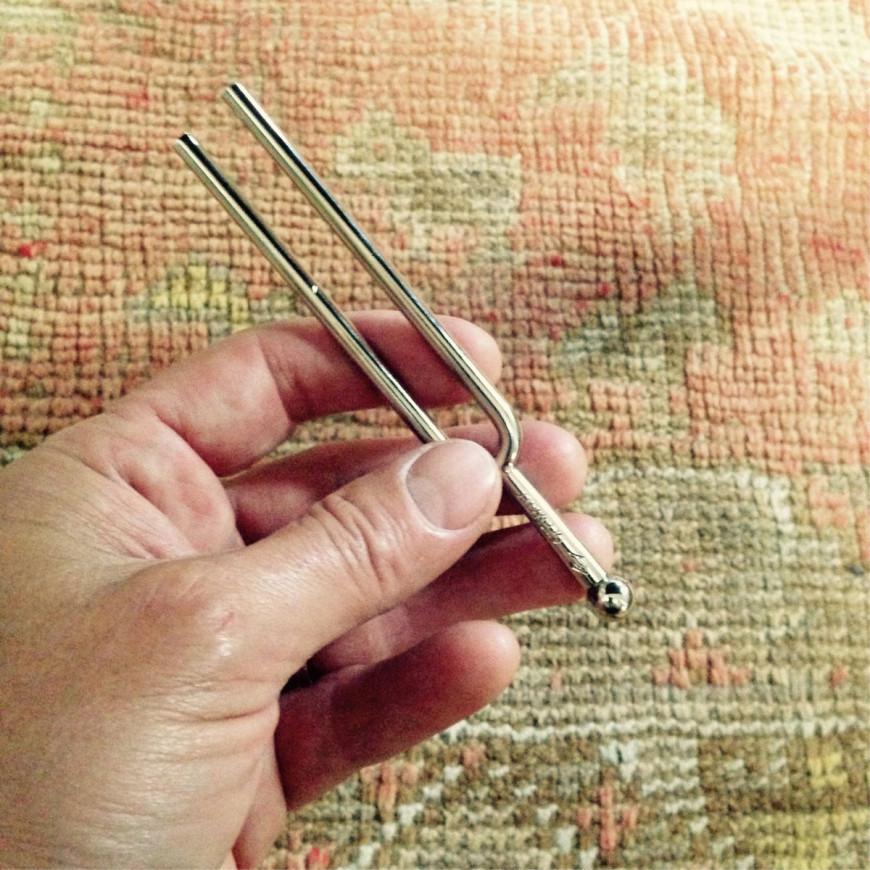How to Tune Your Guitar by Ear Using a Tuning Fork

The miracle of digital tuners and their evolution toward clip-on and app-based tuners has made life better for many a guitarist, but it’s still great to be able to tune your guitar by ear using a tuning fork or some other reference note, like from your friend’s guitar, or a harmonica or piano or some other instrument--anything that doesn’t need a battery! Tuning forks are cool because they are very small and cheap, easily fit in your guitar case or gig bag, and never run out of power. Mine is made in Germany by Wittner and cost less than six bucks. I use it all the time.
| Esoteric note: Most forks you buy will ring an A note at 440 Hz (Hertz, cycles per second). Most digital tuners allow you to change the Hertz setting down as low as 415 Hz and up as high as 465 Hz, those being the outer boundaries of a full half-step down or up. The reason for this is that some instruments that are more difficult to tune quickly--a piano or organ for example--may be pitched at, say, 435 Hz (which, for example, was the recommended tuning pitch for the countries of Austria and France in the late 1800s); it’s much easier to tune your guitar to the pitch of the 435 piano than it would be to tune the entire piano to 440. 440 is the standard for us though. |
It’s helpful to practice listening to what a guitar in standard tuning (EADGBE) sounds like when strummed open across the strings from lowest to highest, and also from highest to lowest. If your guitar is really out of tune when you pick it up, you can give it a quick rough tuning by ear as long as you have a reference note, as from a tuning fork. If you know what the sound of the open strum sounds like, you can pull the guitar close to in-tune, and once you get it close, you can fine tune it using string harmonics as reference notes.
Hold your tuning fork by the base and whack it firmly against something hard; I like to use a piece of wood like the table leg, or, often, my head -- something that won’t scratch the fork (though they are quite durable). The base of most tuning forks has a ball on the end; if you hold that ball end against a wooden box, the note will ring out. I like to hold it against the bridge of my guitar and let the guitar’s soundboard project the note; take care not to scratch your guitar.
It is logistically easier to pluck the harmonic of the A string at the fifth fret before sounding the fork. The fifth fret should be the exact note; the twelfth is the low octave. Use the tuning peg to tune first a bit lower than the note, then “tune up” until the note is the same.
Harmonics:
To get the harmonic, touch the string lightly exactly over the fret with your fretting hand and pluck the string soundly with your picking hand. So to get the fifth fret harmonic, touch the string lightly exactly over the metal of the fifth fret. The twelfth fret harmonic is an octave above the open string; the fifth fret harmonic is two octaves above the open string. The seventh fret harmonic is an octave above the note of the seventh fret. For tuning, we mostly use the fifth and seventh fret harmonics. But to get the reference, match the A tuning fork and the fifth fret harmonic of the A string. You can get reference notes from all over the fretboard using fretted notes, but since every time you fret a note you bend the string, fretted notes will always be ever-so slightly off; harmonics give you the purest note. Also, a fretted note ends as soon as you take your finger off, while harmonics ring clear after you take your finger off--even clearer, actually; you only need to be touching the string while you pluck it. It takes some practice, but it’s not that hard.
It’s cool to note that the twelfth fret harmonic occurs at the exact middle of the string, and the fifth fret harmonic at the exact quarter of the string--you can get the find the same harmonic on the high quarter of the string, although there is no fret to mark it. There are a lot more harmonics that aren’t so cut and dried, but still follow mathematical laws. If you take a fret finger and slowly slide it up the entire length of the string just resting gently on the string, like you would for a harmonic, and pluck continuously--a pick or fingernail produces the clearest harmonic--you will hear a number of harmonics; if you continue up after you reach the middle of the string, above the twelfth fret, you will find a mirror pattern of harmonics along the second half of the string.
“Tune Up”
Any time you’re tuning, whether by ear or with a digital tuner, always “tune up.” This means that you should start below the note and tighten the string to match the note. If the string you are tuning starts higher than the note you’re trying to match, loosen the string and then tune “up” to the note you’re trying to match. The reason for this is that when you tune “down,” the string has relaxing tension on it, and is more likely to slip out of tune; when you tune “up,” tightening up to match the note, you have maximum tension on the string, and it is less likely to slip out of tune.
Oscillation:
To match a note, listen for the oscillation of the soundwaves of the two notes. When the notes are very close, but not matching, you will hear an oscillation, a wah-wah-like effect that slows down as the note of the tightening string approaches closer to the reference note and stops altogether when the notes are perfectly matched; the oscillation ends when the frequencies of the two notes meet at 440 Hz.
Once A is Achieved:
Once you have the A string tuned to the fork, you can put the fork aside; all the reference notes will come from the guitar from here on out. Now use the seventh fret harmonic on the A string as a reference and match the fifth fret harmonic on the low E string to that. Next, use the fifth fret harmonic on the A string as a reference and match the seventh fret harmonic on the D string to that. Next, use the fifth fret harmonic on the D string as a reference and match the seventh fret harmonic on the G string to that.
The B String:
The B string breaks the pattern you will now have recognized. The B note can be made by fretting the G string at the fourth fret and tuning the B string up to match that note. You can also get a B reference on the low E from the seventh fret harmonic; that should be the purer note, and it is easier to let it ring while you tune the B string.
Once you get the B string tuned, it’s back to the pattern: use the fifth fret harmonic on the B string and match the seventh fret harmonic on the high E to that.
You should be in tune.
 Charlottesville, VA - based Ned Oldham, guitarist and songwriter, can be reached for online lessons and correspondence from his teaching page. >>
Charlottesville, VA - based Ned Oldham, guitarist and songwriter, can be reached for online lessons and correspondence from his teaching page. >>
